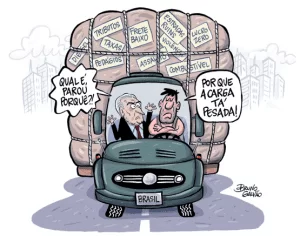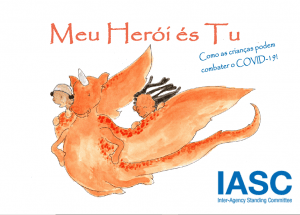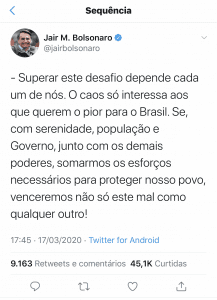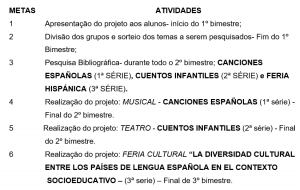ORIGINAL ARTICLE
MONKEN, Priscila Mattos [1]
MONKEN, Priscila Mattos. The expression of the future of the present in the Portuguese language. Revista Científica Multidisciplinar Núcleo do Conhecimento. Year 05, Ed. 12, Vol. 10, pp. 93-105. December 2020. ISSN: 2448-0959, Access link: https://www.nucleodoconhecimento.com.br/lyrics/future-of-the-present
SUMMARY
Given the variety of language categories, it is identified that the employment of the future of the present can be enunciated in different ways. Thus, this article aimed to analyze the verbal forms that express the future of the present within the Portuguese language, verifying the occurrence and behavior of this in cartoons. Later, in other studies, we will deal more specifically, in the variant of the capixabas comics of the authors Milson Henriques and Zappa, under the focus of the theory of Variation, presented by William Labov. Thus, making use of the bibliographic review methodology, we will analyze the three variants that express the future according to concepts addressed by Dubois (2001), Houaiss (2001), Mateus et al (1986), among others. We conclude that, in the comics, there is the predominant use of perifrase, denoting belief in the express event and revealing feelings of the character. However, there is a need to continue our studies in order to expand knowledge about traditional grammar with a focus on the future of the present.
Keywords: Verbal forms, future of the present, linguistic variation.
INTRODUCTION
In Portuguese of Brazil, the future of the present can be enunciated, as a linguistic category, in various ways, such as synthetic (I will leave), the perifriatic or analytical (I will leave) and the present of the indicative (i leave). It is also worth mentioning, although not the focus of our research, the modal forms (I must leave) and the triple forms (I will start going out every night).
Our work is based on the corpus of comics that will be further developed in other studies. This corpus has a written language that resembles oral language, because it is innovative and does not limit itself to the following servile the dictates of normative grammar. We will look at the three variants that express future time, as stated above. Objectives, then, to verify the occurrence and behavior of the future of the present in cartoons to show which are the contexts that favor a certain linguistic form, to later confront research data such as those of other linguistic varieties, such as oral language in newspaper editorials. In a next step, we will analyze the process of grammaticalization that the studied construction goes through. We found that the synthetic form is less and less used, since we see a higher incidence of perifric conjugations that are available in decreasing order of the intensity of the lexical meaning of the auxiliary. We also note that auxiliary verbs gradually lose the notion of time and become modal, since verbs in the construction of the future of the present lose their full meaning and acquire a character of certainty and uncertainty, assumption, condition, need, requirement, possibility or impossibility of a given event. This modality is defined by Ingedore Koch and Mário Villaça (2001) as “the grammaticalization of the subjective attitudes of the speaker and its transposition to the content of the utterance”.
For a better understanding of our research, we clarify some concepts of future and time: the future is defined by Jean Dubois (2001, p. 300) as a “time that is situated the utterance at a moment after the present moment, after now”. It also states that “the future is expressed by combinations of verbal sstatements (He will come) or by adverbs (He comes tomorrow)”.
For Houaiss (2001), the future of the present is a verbal tense of the indicative mode that situates a possible action or a state at an instant later than that in which the speech is located.
Time is conceptualized by Jean Dubois (2001) as a grammatical category usually associated with a verb and which translates several real-time or natural categorizations. Maria Helena de Mira Mateus et al (1986, p. 104) adds that “in Portuguese natural times are the present, the past and the future”, she also makes the observation that since the future always expresses a modal value, in languages in which it is not grammaticalized, it is debatable to consider it a time.
METHODOLOGY
SOCIOLINGUISTIC THEORY
All languages, at any historical time and anywhere, will never be equal -uniforms-, their essential characteristic being heterogeneity. If we travel through Brazil, we can observe different ways of speaking that reveal phonetic, kinetic, morphological, lexical, semantic, pragmatic divergences. There are similarities, however, the different ways of expressing what we think allow us to evaluate the ways of speaking as different ways of expressing oneself.
Even when we study the ways of speaking of people from the same place, we realize that the variety of the language presents differences that correspond to a social diversity such as geographical origin, people’s gender, ethnicity.
The ways of speaking of brazilian cults varies as well. However, they present significant common traits because they are spoken by people with higher education of formal education. Educated speakers, constantly exposed to the standard norm, often seek to approach a cultured-language ideal that we call standard.
The study of the relations between the social and linguistic variants that characterize a certain linguistic phenomenon is called sociolinguistics. The advent of this theory -Sociolinguistics- happened in the 60s in the United States, mainly thanks to Labov’s works, which show us that the language changes and varies, emphasizing the inadequacy of linguistic theories that treat the language as immutable. The objective of sociolinguistics, as in Alkmin (2001), is to study the language spoken in real situations of use.
According to Labov (apud TARALLO, 1990), the term Sociolinguistics is redundant, since every study of language is -or should be- social, because language is a social event, which bases all societies. Labov, since his initial research, relates linguistic phenomenon to social fact. Thus, it is noted that the existing linguistic variation may or may not have a stigmatized character or, on the contrary, of social prestige. According to Scherre (2000), in the Portuguese language, many phenomena such as the absence of agreement -nominal, verbal- are stigmatized, while uses such as the imperative is not. We verified that the use of the perifstic form to indicate the future of the present is not stigmatized, and is even frequently used in written texts.
It is interesting for Sociolinguistics to verify which factors influence the use of the synthetic form to indicate the future of the present and its variants, in this case the perifrástica form (go + infinitive) and the present of the indicative. For this analysis, the variationist sociolinguistics uses a statistical program, Varbrul 2S, which allows calculating the factors that most act on the phenomenon in question.
THE VISION ABOUT THE FUTURE OF THE PRESENT IN SOME GRAMMARS OF THE PORTUGUESE LANGUAGE
The Normative Grammars of Portuguese list some uses of verbal tenses without alluding to aspects underlying their meaning and their functioning, closely relating verbal time at chronological time, even in the face of verbal uses in which there is no such relationship. They turn to the written language, because they dictate rules to regulate and measure the written literary language, without considering linguistic variations, such as the alternation of the synthetic form of expression of the future (I will do) by the perifric form (I´ll do). Thus, they do not offer a complete study on verbs, since their considerations, although they have contributed a lot to the study we propose today, are unsatisfactory. Based on the detection of this aspect, we used descriptive grammar and functionalist grammar to counter the traditional view of the language. The Functionalist Grammar, according to Maria Helena de Moura Neves (1997), has its interest focused on verifying how one obtains the communication of a language, which implies considering the structures of linguistic expressions as configurations of functions, each of which is seen as a different way of meaning in prayer. Thus, the various forms of the future are analyzed there having as reference parameters such as cognition and communication, mental process, social interaction and culture, change and variation, acquisition and evolution.
In the Grammar of Ingedore Koch and Mário Villaça (2001), we see that the verb serves to mark the position that the facts enunciated occupy in time, and that this as a grammatical category, is carried out exclusively by the verb and, as a nocional category, by morphemes, lexemes and other expressions. The authors contribute to the study of the future by differentiating the simple and composed form, adding to the traditional view the notion of aspect. Thus, the simple future is considered as a more linear time, as it indicates facts after the moment of enunciation, while the future compound is used to express the future as a finished event, not exactly indicating time relations.
In descriptive grammar, we try to explain the linguistic mechanisms that involve certain uses of the analytical and synthetic forms of the future of the present.
Our research is about the bias of linguistic analysis proposed by Labov, in which we have linguistic variants that, according to Tarallo (1990), are different ways of saying the same thing in the same context without semantic change. We verified, from this perspective, the preference of some forms instead of others, this happens because language expresses not only the individual by his character of creation, but also the social environment by his character of repetition, acceptance of norm.
THE CORPUS OF RESEARCH: THE ANALYSIS OF COMICS
Penha Lins (2002), in her studies on comic texts, says that these are a modality of language and that they operate with two codes of graphic signs: image and written language. Of the elements that make up the comics, what gives more dynamism to the text are the balloons, which, according to the author, increase the level of meaning. Lyyten (1985) lists, in addition to the most used, the balloon-speech, others such as balloon-thought, balloon-boom, balloon-fear, and clarifies that words and expressions are saved by the effects of this or that balloon.
Onomatopoeia appears in comics associated with a figure or situation, thus complementing language and facilitating the interpretation or induction of this.
Moya (1977) talks about the inclusion of words in the imagery field of comics. It states that words undergo a plastic treatment, are now drawn, becoming important elements for the text.
Comic strips are published daily on internal newspaper pages and their narratives are structured from codes, linguistics and visuals. This language so innovative that combines visual with verbal, that brings us closer to the spoken language, a social reality and that often reveals humor to us, is the ideal basis for our studies of variation of the use of the future of the present, because the comics offer us a study on a written language that by approaching the oral allows us to enter a creative universe and at the same time stuck to grammatical rules.
THE GO PERÍFRASE + INFINITIVE
The use of the perifrástica form to designate the future of the present is little discriminated in the Portuguese. More and more Portuguese speakers choose the use of the go + infinitive perfection in place of the future, which leads us to the belief that we are facing a process of grammaticalization of the perifrase.
The perifric form is entering the spoken language to encode the modality inherent to future time and encode aspect gradually.
The future does not allow the expression of a factual modality, since it has a temporal value, which only accepts assertions according to the evaluation of the possibility or impossibility that the speaker makes about the occurrence of a state of things. In this sense, this circumstance compromises the determination of the truth value of the assumption when it is enunciated, allowing us to affirm that there is always a modal value linked to the temporal value.
To express the future, the speaker uses various verbal forms, such as the present of the indicative, the future of the present of the indicative and the perifric form, which is rarely predicted in traditional grammars.
Commonly the verb go + infinitive is considered as temporal auxiliary, which indicates future, however, less often, we have the verb go as an aspect aid or as a modal verb. Scholars consider the verb go as modal, except for Almeida (1980), do not justify such classification. We thus have a question about the future, whether it belongs to the time category or the mode category. Traditionally, we see as a category time, as stated by Siqueira (1987) and Silva (1997), who consider modal verbs, at most, as an exception. Other scholars, such as Mattoso Câmara Jr., see the expression modality as basic and that of time as derivative. Thus, argues Câmara (1957, p. 223), presenting functional and diachronic arguments: “the advent of the category of future is not determined by the need for temporal expression, certain modal needs materialize it, so that the future begins as a mute”. Eugenio Coseriu (1957) maintains an intermediate position, considering that the future lived is really a modal time. Maria Carlota Rosa (1994), in turn, distinguishes between future and futurity, the first being a morphological category, as we see in the indicator morphemes of that verbal tense, and futurity is a notion that designates the future of the present as an indicative mode and not as verbal time. Sten (apud ROSA, 1999) considers basic temporality in the future and speaks of certain modal uses, which he considers derived from temporal function.
We question whether, in the case of the verb go + infinitive, the designation of futurity is its primordial function, indicated by its morphological aspect of auxiliary, or if the “go” designates futurity by the semantics of the verb itself, being, therefore, a secondary fact, as in modal verbs duty and having that they are considered auxiliary time by Ilari (1997).
GO IN THE SYSTEM OF MODAL VERBS IN AN ACIONAL DESCRIPTION
In an analysis of the semantics of the verb go+ infinitive, from the angle of the Theory of Action, we found that going is part, except for the use in the perfect past of the indicative mode, in the semantic system of modal verbs, and this in the two uses we call the anational and epistemic orientation. In the context of the Theory of Action, elaborated for the modal verbs of German, by Brunner Redder (1983), which is also applicable to modal verbs of the Portuguese language, modal verbs in non-epistemic employment are part of two semantic sets: a set that designates a-kind objectives (belong to this subset, in Portuguese: to go, to want, to want, to want, to intend, to think about, to like, to have of) and the other set and weights of action (power qualifies and weights alternatives of action (power qualifies and weights alternatives of action (power , knowing, being able to, must, need, having to, having to, having to, and, as impersonal modal verbs: fit, fit, comply, fulfill, give to, have to, to be to be of, to be lawful, to be mister, to be necessary, to be possible, to be precious).
Modal verbs that designate an acional objective differ from each other in the following aspects:
– Position in the action process phrases
– (not) Identity between the acional objective-level-up agent and the a-director of the
– Certainty of the acional goal
-Question whether the acional objective is located inside or outside the agent-controlled space.
Modal verbs that qualify and ponder alternatives of action differ in the theme of three questions:
– the question on which the existence of the alternative action in question is based;
– The question of what is the weight attributed to the alternative action in question, in relation to the other possible alternatives, present in the stock of knowledge of the communication partners;
– The question of the result of the weight attributed to the alternative action in question.
Epistemic modal verbs differ:
– As for the genesis of epistemic qualification, whether it is evidencel (intend ing and opinion) or inferential (power, duty, having to have to and not need);
– The type of inference responsible for the source of the evidence;
– As for the probability of the state of themed things (only epistemic-inferential modal verbs)
FUTURE OF THE PRESENT: SOCIOLINGUISTIC VISION
As seen in the section referring to the methodology, Labovian Sociolinguistics proposes to study the relationship between language and society, considering the linguistic system as heterogeneous, but susceptible to systematization. It is important for Sociolinguistics to verify the existence of variant forms and whether such forms tend to become a change or not. Yacovenco (2002) considers that when studying a phenomenon in variation or change, it is necessary to follow the following steps: restrictions; fit, evaluation and transition; Implementation. In the restrictions phase, we established the variables, social or linguistic, which influence the analyzed phenomenon. In the case of the future of the present, based on Gibbon’s study (2001), we established the following linguistic variables: verbal mode, semantic type of the verb, person of speech, influence of auxiliary verbs, marks of futurity. We add the factor parallelism as active on the use of one of the independent variables.
In the step called docking, we analyze how variation and change affect so-called a language. Also in this phase, the evaluation occurs, which refers “to the study on changes and their effects on linguistic structure and communicative efficiency” (YACOVENCO, 2002, p. 158). Therefore, we base the research on American Functionalism, so that we try to explain, based on the precepts of this theory, the grammaticalization of the perifrástica form. This step will be further developed in future work.
The transition and implementation refer to the linguistic change itself. The first verifies the intermediate stages between variation and change, while the second seeks to evaluate what are the factors involved in the effectuation of linguistic change.
We will analyze below the linguistic factors that influence the use of the future of the present in the Portuguese language.
VERBAL MODE
According to Gibbon (2003), the perifrase tends to appear linked to the times of the indicative mode and is inhibited by the subjunctive, since this mode is considered as uncertainty, doubt and hypothesis, while the indicative marks the certainty about the assertion. Gibbon then verifies the influence of the verb mode of the bound prayer on the use of the perifrástica form. According to some authors (MATEUS et al., 1993 apud GIBBON, 2003), the perifsiastic form should be interpreted as modal, expressing certainty as to the realization of the fact expressed in the assertion. However, we note that, because the indicative mode expresses the modality, the indication of future time is expressed by the perifrástica form, being, therefore, this form in the process of grammaticalization, not being entirely up to it the function of encoding time, because its initial motivation would be to mark the modality.
SEMANTIC TYPE OF THE VERB
As Gibbon (2003) points out, verbs, which are characterized by indicating movement, restrict the use of the perifrástica form to indicate the future of the present, because, if the use of the partphrase occurred, there would be a double marking of movement. Thus, verbs with motion denotation are more likely to use the present or synthetic form to indicate the future of the present. On the other hand, we observed (GIBBON, 2003) that the main conditioning factor of the use of the perifstic form is the static character of the verb, both in the prayer linked to the data and in the main verb itself that is paired with the GO in the perifrase.
SPEECH PERSON
According to Gibbon’s study (2003), one of the conditioning factors of the use of the perifriatic form is the participation of interlocutors, that is, the presence of the first and second person of the discourse, since, alongside the notion of temporality, there is, as already affirmed, the notion of modality in the expression of the future by the analytical form. One of the issues addressed is that the presence of interlocutors favors the expression of certainty and other intentionality, in enunciation, hence the favoritism of the perifstic form. Conversely, the factor that inhibits this form is the use of the third person in the discourse, possibly because it is a form that does not involve participants of the interaction, thus not compromising the utterance.
PARTIAL CONCLUSIONS
We believe that in the comics, due to our initial study, we have more use of the peryphrine, denoting more belief in the event expressed by the characters as well as revealing feeling. We noticed that in a situation of greater informality the perfection is widely used and thus, in the hybrid genre of comics, we thought that this would be a justification of the choice for such forms of expression.
As we begin our research, we felt the need to expand our knowledge about the proposals of traditional grammars regarding the expression of the future of the present. As a result, we will continue our studies for a more humanized teaching and for life, which breaks with the dynamics of repeating and reproducing content.
BIBLIOGRAPHICAL REFERENCES
ALKMIN, Tânia Maria. Sociolinguística. In: MUSSALIN, Fernanda, BENTES, Anna Christina (orgs). Introdução à linguística: domínios e fronteiras. São Paulo: Cortez, 2001.
BECHARA, Evanildo. Moderna gramática da língua portuguesa. Rio de Janeiro: Lucerna, 2002.
CAMARA JR., Joaquim Mattoso. História e estrutura da língua portuguesa. Rio de Janeiro: Padrão, 1975.
CUNHA, Celso e CINTRA, Lindley. Nova gramática do português contemporâneo. Rio de Janeiro: Nova Fronteira,2000.
GIBBON, Adriana de Oliveira. A expressão do tempo futuro na língua falada de Florianópolis: gramaticalização e variação. Boletim da Abralin. N 26, vol. 2, 2003:29-32.
GIBBON, Adriana de Oliveira. A gramaticalização da forma perifrástica (ir+infinitivo) como codificadora do tempo futuro: o percurso a partir de fatores semânticos, discursivos e sociais. Cadernos do CNLF, série IV, n7, 2000 (versão on-line).
JOHNEN, Thomas. Da integração semântica de ir + infinitivo no sistema dos verbos modais numa perspectiva de descrição semântica no âmbito de uma teoria de ação. Filologia e linguística portuguesa. São Paulo, Humanitas, V. S, pl143-176, 2003.
LINS, Maria da Penha Pereira. O humor em tiras de quadrinhos: uma análise de alinhamentos e enquadres em Mafalda. Vitória: Grafer,2002.
LUFT, Celso Pedro. Moderna Gramática Brasileira. São Paulo: Globo,2000.
MATEUS, Maria Helena Mira et al. Gramática da língua portuguesa. Coimbra: Almedina,1983.
NEVES, Maria Helena de Moura. A gramática funcional. São Paulo: Martins Fontes, 1997.
NEVES, Maria Helena de Moura. A gramática funcional. São Paulo: Martin Fontes, 2001.
NEVES, Maria Helena de Moura. Gramática do português falado. Vol. VII. São Paulo: editora da UNICAMP, 1999.
VILELA, Mário e KOCH, Ingedore Villaça. Gramática da Língua Portuguesa. Coimbra: Almedina, 2001.
[1] Master’s degree in Cognition and Language. Specialization in Text Review. Graduation in Letters Portuguese.
Submitted: December, 2020.
Approved: December, 2020.





